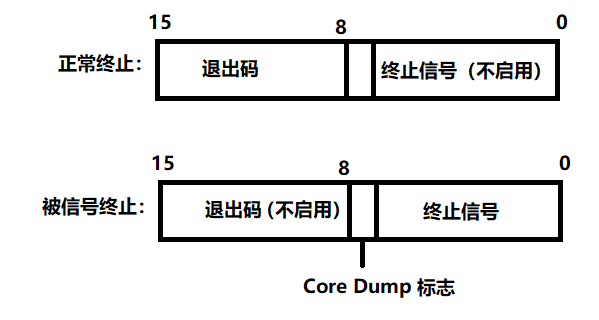Linux環境下編寫簡單的Shell
阿新 • • 發佈:2018-11-23
使用程序建立、等待、終止等知識自主實現簡單的Linuxshell命令列,Linux環境:CentOS7.3
程序建立
建立程序的方式
- 通常使用fork()函式來建立一個新程序,新程序為子程序,而原來的程序即為父程序。在Linux中fork()是一個非常重要的函式,它的標頭檔案為<unistd.h>。
- 通過vfork()也可以來建立一個子程序,它的返回值與fork()相同。
fork()的返回值
fork()函式有兩個返回值,它會給子程序返回0,給父程序返回子程序的pid,如果建立子程序失敗,則會返回-1。
寫時拷貝
通過fork()建立的子程序與父程序會共享同一份程式碼,因為程式碼段的資料是隻讀的,不會發生寫入,而當父程序與子程序的資料段不發生寫入時,它們的資料段也是共享的,當子程序或父程序任何一方發生寫入時,就會另外開闢自己的資料段,將原來的資料拷貝過去
fork()與vfork()的區別
- 通過vfork()函式建立的子程序與父程序共享同一塊地址空間,而通過fork()建立的子程序與父程序各自擁有自己獨立的地址空間。
- 通過vfork()建立程序會保證子程序先執行,等到子程序呼叫exec(程序替換)或exit(退出)之後,父程序才會被執行。
程序終止
程序終止的情況
正常終止(可以通過echo $?來檢視退出碼,echo $?只可檢視最近一次退出的程序的退出碼)
- 從main主函式返回(return):呼叫main函式執行時,函式會將main的返回值當做exit()的引數
- 呼叫exit函式:exit()函式的引數即為退出碼
- _exit
異常退出
- 通過對程序傳送訊號終止程序
_exit(int status)與exit(int status)的區別
- _exit()相比exit()而言,退出的更加粗暴直接,而exit()在程序退出之前,還會做許多收尾工作,但在exit()函式中,最終還是會呼叫_exit()。
程序等待
程序等待的意義
- 子程序退出,如果父程序不採取措施,那麼子程序就會變成一個殭屍程序,而殭屍程序會造成作業系統記憶體洩露。
- 子程序退出時,會返回子程序任務的執行資訊,父程序需要獲取到子程序的退出資訊。
程序等待的方式
wait方法&waitpid方法
#include<sys/types.h>
#include<sys/wait.h>
pid_t wait(int* status);
返回值:
成功返回則返回被等待程序的ID,失敗返回0
引數:
獲取子程序的退出狀態,不關心則設定為NULL
pid_t waitpid(pid_t pid, int* status, int options);
返回值:
當waitpid收集到已退出的子程序時waitpid返回被等待程序的ID
如果設定了選項WNOHANG,而呼叫waitpid發現沒有已退出的子程序可以被收集時,則返回0
引數說明:
pid:
pid=-1,等待任意一個子程序,與wait效果相同。
pid>0,等待程序ID與pid相等的子程序。
status:
WIFEXITED(status): status若為正常終止子程序返回的狀態,則為真。
WEXITSTATUS(status): 若WIFEXITED非零,提取子程序提出碼。
options:
WNHANG:若pid指定的子程序沒有結束,則waitpid()函式返回0,不予以等待。若正常結束,則返回該子程序的ID。
- 如果子程序已經退出,則呼叫wait/waitpid時,wait/waitpid會立即返回,並且釋放資源,並獲得子程序退出資訊。
- 如果當呼叫wait/waitpid時子程序存在並且正常執行,則程序可能阻塞。
- 如果不存在該子程序,則立即出錯返回。
子程序退出資訊status
- 子程序的退出資訊會被作業系統儲存在status內,當我們使用wait/waitpid時,如果想知道子程序的退出資訊,就必須定義一個int型別的變數,將該變數的地址傳給wait/waitpid,作業系統就會將收集到的子程序的退出資訊儲存在該變數內。
- 當子程序的退出資訊我們不需要時,亦可以傳遞NULL空指標
- status雖然是一個整型變數,但是它並不是代表一個簡單的整型數字,它可以當作點陣圖來看待。
- status示意圖:(僅研究status的低16位元位)

程式碼實現簡單的shell
設計思想
- 建立父程序,父程序的工作為列印shell提示資訊,等待標準輸入輸入命令
- 當命令輸入之後,父程序建立子程序,子程序的工作為使用exec()函式進行程序替換
- 在子程序執行的過程中,父程序持續等待子程序,待子程序退出之後,父程序即可繼續迴圈
#include<stdio.h>
#include<stdlib.h>
#include<sys/wait.h>
#include<string.h>
#include<unistd.h>
#define MAX_ARGV 20
#define MAX_CMD 1024
void cut_str(char* argv[],char cmd[])//將輸入的命令分段,儲存至argv[]指標陣列內
{
char* ptr=cmd;
int i=0;
int flag=0;
while(*ptr!='\0')
{
if(*ptr!=' '&&flag==0)
{
argv[i++]=ptr;
flag=1;
}
else if(*ptr==' '&&flag==1)
{
*ptr='\0';
argv[i++]=ptr+1;
}
ptr+=1;
}
//去掉命令尾部的'\n'
ptr=argv[i-1];
while(*ptr!='\0')
{
ptr+=1;
}
*(ptr-1)='\0';
//以NULL結尾
argv[i]=NULL;
}
void new_pro(char* argv[])
{
pid_t id=fork();
if(-1==id)
{
perror("fork");
exit(-1);
}
else if(0==id)//子程序
{
execvp(argv[0],argv);
}
else//父程序
{
int st;//定義st用來儲存子程序的返回資訊
while(wait(&st)!=id);//使用while迴圈為了確保wait()收集到的子程序是上面所建立的子程序
}
}
int main()
{
char cmd[MAX_CMD]={'\0'};//定義陣列來儲存輸入的內容
char* argv[MAX_ARGV];//定義一個數組來存放argv(execvp()函式的第二個引數)
while(1)
{
printf("[[email protected] ~ ]& ");//列印shell提示符
//此處不能使用scanf()函式來接受,因為scanf()在用“%s”格式輸入字元時,輸入的字串中含有空白字元(space,tab,newline)。字串讀取結束
fgets(cmd,sizeof(cmd),stdin); //從標準輸入來接受將要執行的命令
cut_str(argv,cmd);//將輸入的命令切開,並將其的地址存入陣列argv[],最終以NULL結尾
new_pro(argv);//新程序,在此函式內會建立一個子程序,在子程序執行的時候,父程序會等待子程序,待到子程序執行完畢,父程序才會繼續向下執行
}
return 0;
}
封裝fork/wait函式,編寫函式process_create(pid_t* pid,void* fun ,void* arg),func回撥函式就是子程序執行的函式入口,arg是傳遞給func回撥函式的引數
#include<sys/wait.h>
#include<unistd.h>
#include<stdio.h>
#include<stdlib.h>
void process_create(pid* pid, void func, void* arg)
{
*pid = fork();
typedef void (PF*)(void* arg);//重新命名一個返回值為void,只有一個引數為void*函式指標PF,用來對回撥函式強制轉換
if(-1 == *pid)//建立子程序失敗
{
exit(-1);
}
else if(0 == *pid)//子程序
{
if(NULL == func)//判斷是否傳遞迴調函式地址
{
printf("未傳遞迴調函式地址!\n");
exit(0);
}
((PF)func)(arg);//執行func函式,先要進行強制型別轉換
exit(0);
}
else//父程序
{
int st;
while(wait(&st) == *pid);
}
}
fork+exec與system/popen的區別
system函式
#include<stdlib.h>
int system(const char* command);
- system函式用來在程式中執行shell命令列的命令。
system的原始碼
int system(const char *command)
{
struct sigaction sa_ignore, sa_intr, sa_quit;
sigset_t block_mask, orig_mask;
pid_t pid;
sigemptyset(&block_mask);
sigaddset(&block_mask, SIGCHLD);
sigprocmask(SIG_BLOCK, &block_mask, &orig_mask); //1. block SIGCHLD
sa_ignore.sa_handler = SIG_IGN;
sa_ignore.sa_flags = 0;
sigemptyset(&sa_ignore.sa_mask);
sigaction(SIGINT, &sa_ignore, &sa_intr); //2. ignore SIGINT signal
sigaction(SIGQUIT, &sa_ignore, &sa_quit); //3. ignore SIGQUIT signal
switch((pid = fork()))
{
case -1:
return -1;
case 0:
sigaction(SIGINT, &sa_intr, NULL);
sigaction(SIGQUIT, &sa_quit, NULL);
sigprocmask(SIG_SETMASK, &orig_mask, NULL);
execl("/bin/sh", "sh", "-c", command, (char *) 0);
exit(127);
default:
while(waitpid(pid, NULL, 0) == -1) //4. wait child process exit
{
if(errno != EINTR)
{
break;
}
}
}
}
- system函式在執行的過程中,在子程序沒有退出前,父程序會一直等待,直到子程序執行結束,所以system是序列執行。
- system對SIGCHLD、SIGINT、SIGQUIT訊號做了處理
popen函式
#include<stdio.h>
FILE* popen(const char* command, const char* type);
int pclose(FILE* stream);
popen()也是執行shell命令並且通過管道和shell命令進行通訊。
popen原始碼
static pid_t *childpid = NULL;
/* ptr to array allocated at run-time */
static int maxfd; /* from our open_max(), {Prog openmax} */
#define SHELL "/bin/sh"
FILE *
popen(const char *cmdstring, const char *type)
{
int i, pfd[2];
pid_t pid;
FILE *fp;
/* only allow "r" or "w" */
if ((type[0] != 'r' && type[0] != 'w') || type[1] != 0) {
errno = EINVAL; /* required by POSIX.2 */
return(NULL);
}
if (childpid == NULL) { /* first time through */
/* allocate zeroed out array for child pids */
maxfd = open_max();
if ( (childpid = calloc(maxfd, sizeof(pid_t))) == NULL)
return(NULL);
}
if (pipe(pfd) < 0)
return(NULL); /* errno set by pipe() */
if ( (pid = fork()) < 0)
return(NULL); /* errno set by fork() */
else if (pid == 0) { /* child */
if (*type == 'r') {
close(pfd[0]);
if (pfd[1] != STDOUT_FILENO) {
dup2(pfd[1], STDOUT_FILENO);
close(pfd[1]);
}
} else {
close(pfd[1]);
if (pfd[0] != STDIN_FILENO) {
dup2(pfd[0], STDIN_FILENO);
close(pfd[0]);
}
}
/* close all descriptors in childpid[] */
for (i = 0; i < maxfd; i++)
if (childpid[ i ] > 0)
close(i);
execl(SHELL, "sh", "-c", cmdstring, (char *) 0);
_exit(127);
}
/* parent */
if (*type == 'r') {
close(pfd[1]);
if ( (fp = fdopen(pfd[0], type)) == NULL)
return(NULL);
} else {
close(pfd[0]);
if ( (fp = fdopen(pfd[1], type)) == NULL)
return(NULL);
}
childpid[fileno(fp)] = pid; /* remember child pid for this fd */
return(fp);
}
- popen在執行的過程中,父程序並沒有等待子程序執行完成,所以popen是並行執行。
- 使用popen函式時,必須在呼叫popen函式之後呼叫pclose函式來回收子程序,否則子程序就會變成一個殭屍程序,會造成作業系統記憶體洩漏。
- popen函式沒有遮蔽SIGCHLD、SIGINT、SIGQUIT訊號。
